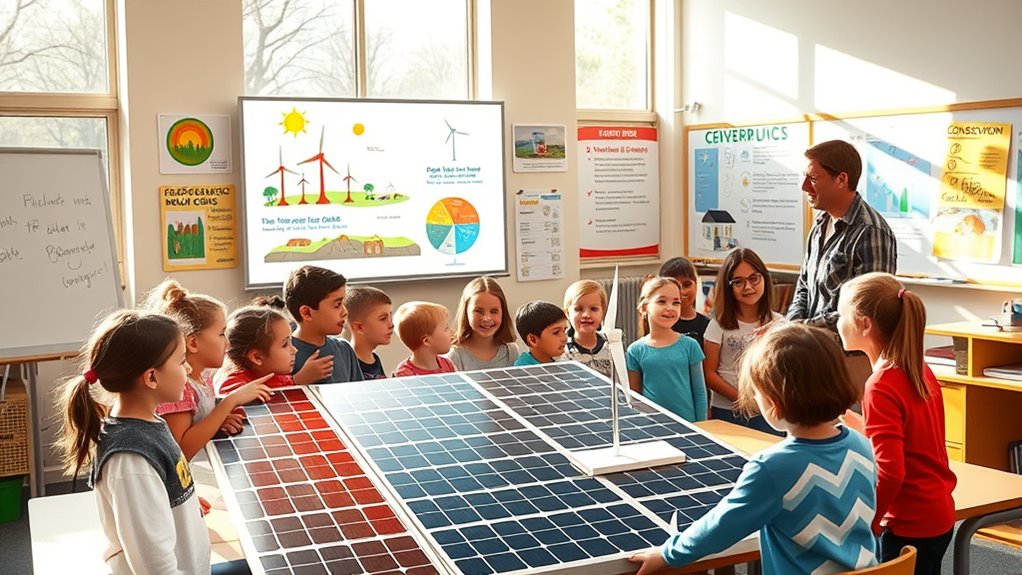Teaching renewable energy and conservation in schools helps you show students how their choices impact the planet. Use hands-on activities, like building solar-powered devices or model wind turbines, to make concepts tangible and inspire curiosity. Incorporate lessons on energy conservation, efficiency, and policies across different subjects. Showing real-world examples and career opportunities encourages future sustainability advocates. Keep exploring how you can create engaging lessons that empower students to become eco-conscious leaders.
Key Takeaways
- Incorporate hands-on activities like building solar-powered devices to engage students in renewable energy concepts.
- Integrate energy conservation lessons into daily routines to promote responsible habits.
- Use interdisciplinary approaches combining science, math, and social studies to deepen understanding of sustainable energy.
- Highlight real-world examples and career opportunities to motivate interest in renewable energy fields.
- Utilize visual aids and experiments to make complex energy topics tangible and inspire curiosity.

Have you ever wondered how we can build a sustainable future? Teaching renewable energy and conservation in schools is an essential step toward that goal. When you introduce students to the basics of renewable energy, you help them understand how their choices impact the planet. One engaging way to do this is by exploring how solar panels and wind turbines work. Solar panels capture sunlight and convert it into electricity, providing clean energy for homes and schools. Wind turbines, on the other hand, harness the power of moving air to generate electricity. Showing students these technologies makes the concepts tangible and real, inspiring curiosity and a sense of possibility.
By incorporating hands-on activities, you allow students to see renewable energy’s potential firsthand. For example, you might organize a project where students build small solar-powered devices or model wind turbines. These activities demonstrate how renewable energy sources can supplement or replace traditional fossil fuels, reducing greenhouse gas emissions. As students experiment and troubleshoot, they learn about the importance of innovation and problem-solving in creating sustainable solutions. Incorporating visual aids can further enhance understanding of complex energy concepts and keep students engaged.
Teaching about energy conservation is equally essential. You can encourage students to analyze their daily habits—like turning off unused lights or reducing water consumption—and understand how small actions contribute to larger environmental benefits. Emphasizing energy efficiency helps students realize that conserving energy is just as crucial as generating it sustainably. This understanding fosters responsible behaviors that can last a lifetime.
Integrating lessons on renewable energy into science, social studies, or math curricula makes the concepts more relatable. For instance, students can calculate how much energy a solar panel or wind turbine can produce, compare costs, or explore policies supporting renewable energy adoption. This interdisciplinary approach broadens their understanding and shows how science connects with economics and civic responsibility.
Furthermore, discussing the broader impact of renewable energy helps students appreciate its role in combating climate change and creating green jobs. When you present real-world examples of communities utilizing solar and wind power, students see the tangible benefits and opportunities these technologies offer. This awareness can motivate them to advocate for renewable energy policies and pursue careers in sustainability fields.
Ultimately, teaching renewable energy and conservation in schools empowers students to become informed citizens and future innovators. By making these topics accessible and engaging, you inspire a new generation capable of making meaningful changes. You’re not just imparting knowledge; you’re cultivating a mindset that values sustainability, responsibility, and innovation—key ingredients for building a cleaner, greener future.
Frequently Asked Questions
How Can Teachers Effectively Integrate Renewable Energy Topics Into Existing Curricula?
You can effectively integrate renewable energy topics into your existing curricula by focusing on curriculum integration and thoughtful lesson planning. Start by identifying relevant subjects like science, social studies, or math, then develop engaging lessons that connect renewable energy concepts to each. Use real-world examples, hands-on activities, and interdisciplinary approaches to make the topics meaningful. This approach keeps lessons cohesive while inspiring students to understand and appreciate renewable energy’s importance.
What Are the Best Hands-On Activities for Teaching Energy Conservation to Students?
To teach energy conservation effectively, you can organize engaging hands-on activities like solar experiments, where students build small solar ovens or panels, showing how sunlight converts to energy. Conduct energy audits in your school, guiding students to identify energy waste and suggest improvements. These activities make learning interactive, help students understand conservation principles, and inspire them to adopt sustainable habits in everyday life.
How Can Schools Measure the Impact of Energy Education Programs?
You can measure the impact of your energy education programs by tracking student engagement through surveys, participation rates, and behavioral observations. Conduct regular program evaluations to assess knowledge gains and attitude shifts about energy conservation. Use pre- and post-program assessments, feedback forms, and energy consumption data to determine how effectively students apply what they’ve learned. This approach helps you understand the program’s success and areas needing improvement.
What Funding Opportunities Are Available for Renewable Energy Educational Initiatives?
You can explore various funding sources and grant opportunities to support your renewable energy educational initiatives. Look into government programs like the DOE’s Office of Energy Efficiency and Renewable Energy, private foundations, and local grants aimed at sustainability. Applying for these grants can provide the financial backing needed to develop engaging curriculum materials, install renewable energy projects, and fund training sessions, making your initiatives more impactful and sustainable.
How Do Cultural Differences Influence Renewable Energy Education Strategies?
Have you ever wondered how cultural perceptions shape renewable energy education? You’ll find that cultural differences profoundly influence strategies, as they affect community engagement and receptiveness. Addressing educational disparities requires tailoring approaches to respect local values and beliefs. By understanding these cultural nuances, you can create more inclusive programs that resonate with diverse students and communities, making renewable energy education more effective worldwide.
Conclusion
By teaching renewable energy and conservation in schools, you’re planting seeds for a sustainable future. Remember, “The early bird catches the worm,” so start now to inspire future generations to make eco-friendly choices. Your efforts can empower students to become responsible stewards of our planet, ensuring cleaner air, water, and energy for all. Together, you can turn knowledge into action and lead the way toward a greener, more sustainable world.










